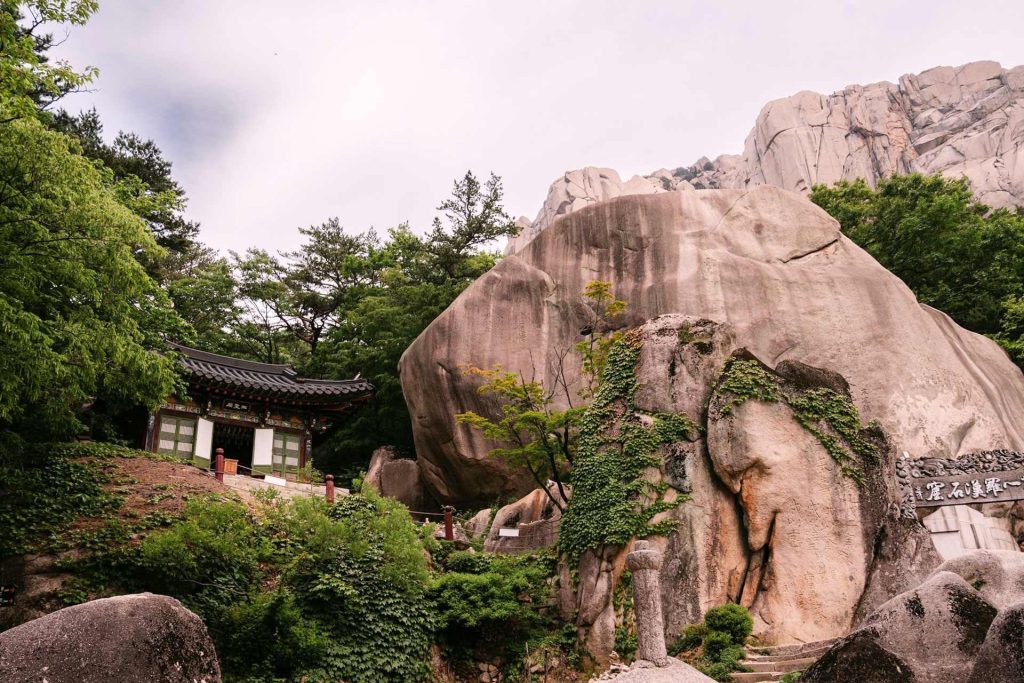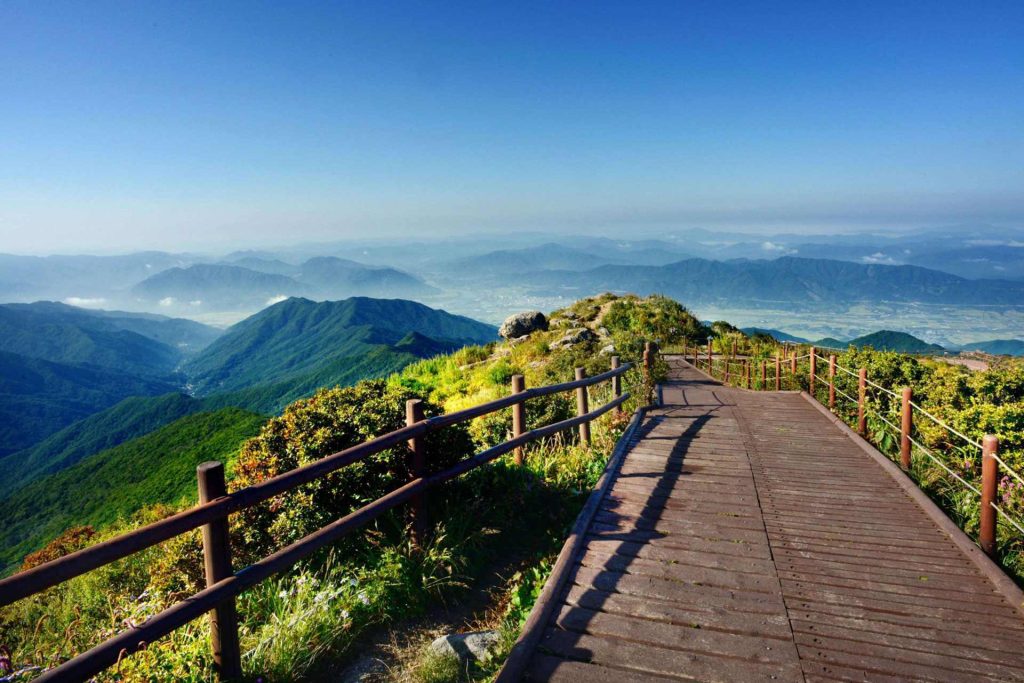Seoraksan National Park is one of the most beautiful natural destinations in South Korea. Located in the mountainous northeastern region, Seoraksan offers a unique combination of rugged landscapes, dense forests, and crystal-clear waterfalls. With its lush biodiversity and deep cultural significance, this park is perfect for hikers and those seeking to connect with nature. From its towering peaks to the serene temples hidden in its valleys, Seoraksan invites you to explore and discover the beauty of Korean nature at its finest.
Content
- 1 Information about Seoraksan National Park
- 2 How to Get to Seoraksan National Park
- 3 Geography of Seoraksan in Gangwon
- 4 Flora of Seoraksan National Park in South Korea
- 5 Fauna of Seoraksan
- 6 Recommended Tours and Activities
- 7 What to See and Do in Seoraksan National Park
- 7.1 Cheonbuldong Valley
- 7.2 Daecheongbong Peak
- 7.3 Biseondae Cave
- 7.4 Sinheungsa Temple
- 7.5 Yukdam Waterfall
- 7.6 Biryong Waterfall
- 7.7 Seoraksan Cable Car
- 7.8 Gwongeumseong Suspension Bridge
- 7.9 Ulsanbawi Rock
- 7.10 Osaek Mineral Spring
- 7.11 Thermal Baths and Relaxation
- 7.12 Hiking the Peaks of Seoraksan
- 7.13 Rock Climbing
- 7.14 Landscape Photography
- 8 Historic Villages and Cultural Heritage in Seoraksan National Park
- 9 Gastronomy in Seoraksan National Park
- 10 Accommodations in Seoraksan National Park
Information about Seoraksan National Park
History of Seoraksan National Park
Seoraksan National Park (in Korean: 설악산국립공원) was designated a national park in 1970, covering an area of 163.6 square kilometers. In 1982, UNESCO recognized it as a Biosphere Reserve due to its rich biodiversity and unique geography, which includes numerous mountain peaks over 1,200 meters, with Daecheongbong as the tallest at 1,708 meters. The park’s mountain ranges are mostly composed of granite and gneiss and receive annual precipitation ranging from 1,000 mm inland to 1,300 mm in the outer areas.
Over the centuries, Seoraksan has been considered a sacred place, hosting ancient Buddhist temples dating back to early times, giving it a profound spiritual connection. Its strategic location also marked the region’s history, as ancient trade routes connected the east and west of Korea, blending nature and culture in a unique setting.
The park also hosted an important international event in 1991, the 17th World Scout Jamboree, held from August 9 to 16 on Mount Seorak. This event brought together thousands of Boy Scouts and Girl Scouts from around the world to participate in activities, games, and discussions on environmental topics, promoting cultural exchange and forging international friendships in the heart of Seoraksan.
Location of Seoraksan National Park
The park is located in Gangwon Province, on South Korea’s northeastern coast, about 180 kilometers from Seoul. Its proximity to coastal cities like Sokcho makes it an ideal destination for those wishing to enjoy both the mountains and the sea in one visit.
Best Time to Visit Seoraksan
Seoraksan National Park is spectacular year-round, but each season offers a unique experience. Autumn is particularly famous for the vibrant colors of the trees, which blanket the mountains in golden and red hues, while spring adorns the trails with wildflowers. Winter is also popular with visitors who enjoy snowy landscapes and cold-weather hikes.
How to Get to Seoraksan National Park
From Seoul
The most common way to reach Seoraksan from Seoul is by bus. Express buses from Seoul’s Central Terminal to Sokcho take approximately 2.5 hours. From Sokcho, a local bus can take you directly to the park’s entrance.
From Sokcho
Sokcho is the closest city to the park, and frequent buses connect the city center with the main entrance of Seoraksan. The trip is short, about 20 minutes, making it the best option for those staying nearby.
From Gangneung
If you are in Gangneung, another popular coastal city, you can take a bus to Sokcho, which takes about an hour. From there, follow the same route to the park.
From Incheon
From Incheon Airport, it is possible to take a direct bus to Sokcho or Seoraksan, making it convenient for visitors arriving from abroad.
Geography of Seoraksan in Gangwon
Seoraksan is renowned for its rugged peaks and deep valleys. The highest point is Daecheongbong Peak, rising to 1,708 meters above sea level, offering spectacular views to hikers who reach its summit. The park is also traversed by rivers and streams, contributing to the formation of stunning waterfalls, such as Biryong Falls.
Flora of Seoraksan National Park in South Korea
The park is home to many plant species. Along its trails and paths, you’ll find dense forests of pines, maples, and oaks, alongside a rich variety of alpine plants in higher altitudes. In autumn, these trees transform into a warm mosaic of colors, attracting photographers and nature enthusiasts.
Fauna of Seoraksan
The wildlife in Seoraksan includes rare and endangered species, such as the Asiatic black bear, mountain goral, and various birds of prey. Lucky hikers may catch a glimpse of some of these animals in their natural habitats, especially in the park’s less-traveled areas.
Recommended Tours and Activities
What to See and Do in Seoraksan National Park
Cheonbuldong Valley
This valley is one of Seoraksan’s main attractions, known for its unique rock formations and the crystal-clear river that flows through it.
Daecheongbong Peak
The highest point in the park offers stunning panoramic views and is one of the most popular hiking destinations in South Korea.
Biseondae Cave
A rock formation that has inspired numerous local legends. The cave offers a peaceful retreat for hikers seeking a break.
Sinheungsa Temple
This Buddhist temple is one of the oldest in Korea and houses a giant Buddha statue that welcomes visitors at the foot of the mountains.
Yukdam Waterfall
A serene waterfall flowing through a narrow canyon, perfect for a refreshing stop during a hike.
Biryong Waterfall
One of the most famous waterfalls in Seoraksan, known for its impressive drop and the crystal-clear pools surrounding it.
Seoraksan Cable Car
A relaxed way to enjoy the park’s views is by taking the cable car to Gwongeumseong, where you can enjoy breathtaking panoramic vistas.
Gwongeumseong Suspension Bridge
From the cable car, you can walk to this suspension bridge, which offers unmatched views of the surrounding mountains and valleys.
Ulsanbawi Rock
A towering rock formation that attracts hikers with its challenging climb and the views from its summit.
Osaek Mineral Spring
Famous for its natural mineral waters, this area is ideal for a relaxing break after a hike.
Thermal Baths and Relaxation
The Osaek area also offers natural hot springs, where you can unwind and enjoy the park’s natural surroundings.
Hiking the Peaks of Seoraksan
Seoraksan is a paradise for hikers, with trails ranging from easy walks to challenging climbs to the highest peaks. The ascent to Daecheongbong Peak is a favorite; while demanding, it rewards hikers with unparalleled views.
Rock Climbing
For the more adventurous, Seoraksan offers numerous opportunities for rock climbing, especially on the Ulsanbawi rock formations.
Landscape Photography
With its waterfalls, mountains, and seasonal landscapes, Seoraksan is a dream for photographers. The best times to capture the park’s beauty are at sunrise and sunset.
Historic Villages and Cultural Heritage in Seoraksan National Park
Buddhist Influence in the Region
The park is home to several Buddhist temples, many of which date back centuries. These temples reflect the deep connection between nature and spirituality, offering an experience of peace and reflection.
Nearby Historic Sites
Near the park, there are other culturally significant historic sites, such as fortresses and temples, which complement a visit to Seoraksan.
Gastronomy in Seoraksan National Park
Local Specialties of Sokcho
Sokcho, the nearest city to the park, is known for its fresh fish and seafood, where you can enjoy authentic Korean meals made with local ingredients.
Traditional Korean Dishes
Korean cuisine is an essential part of the Seoraksan experience. From the famous bibimbap to hearty soups, nearby restaurants offer a wide variety of options.
Fresh Fish and Seafood
Sokcho’s market is famous for its fresh fish and seafood. You can try dishes prepared on the spot with ingredients caught the same day.
Mountain Products and Vegetables
Mountain products, such as mushrooms and fresh vegetables, are common ingredients in the dishes served around the park.
Accommodations in Seoraksan National Park
Accommodations in Sokcho
Sokcho offers a wide range of accommodations, from modern hotels to cozy traditional guesthouses. It is the most convenient place to stay if you plan to explore Seoraksan.
Accommodations in Yangyang
Yangyang is another nearby option, with quieter accommodations and access to other natural attractions in the region.
Accommodations in Osaek
The Osaek area, known for its hot springs, offers more rural accommodations for those seeking a closer connection to nature.
Camping in Seoraksan
For adventurers, the park has designated camping areas, providing a more immersive experience in nature.
Recommended next parks: South Korean National Parks.


